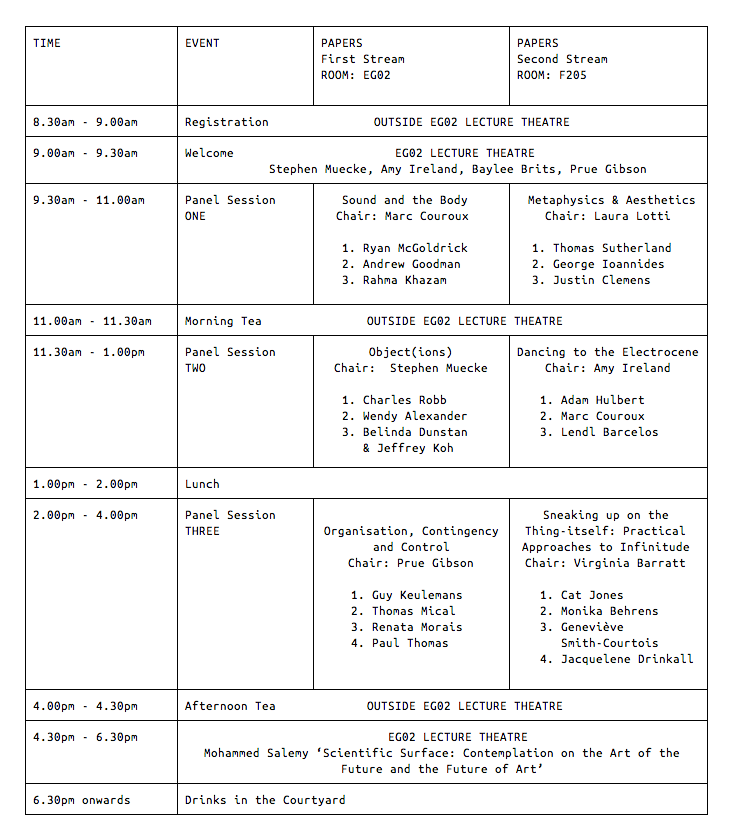February 5th
THURSDAY
First Stream (EG02 Lecture Theatre)
PANEL ONE
Sound and the Body
Marc Couroux (Chair)
Ryan McGoldrick - ‘Bio/Neuro Immersion in Digital Interactive Environments: The Post-human Aesthetics of Pia Van Gelder’s ‘Psychic Synth’ (2014)’
Andrew Goodman - ‘The Noise in the Noise: Micro-Perception as Affective Disruption to Listening and the Body’
Rahma Khazam - ‘Out of Earshot, Out of Mind, the Tribulations of Object-Oriented Sound (Part II)‘
PANEL TWO
Object(ions)
Stephen Muecke (Chair)
Charles Robb - ‘The Ways of Things: objects and agency in the studio’
Wendy Alexander - ‘Between and Within: An Object-Oriented Inquiry (OOI) of South Asia in Australia’
Belinda Dunstan and Jeffrey Koh - ‘Robots Suck, but You Suck More: A Visual Survey’
PANEL THREE
Organisation, Contingency, and Control
Prue Gibson (Chair)
Guy Keulemans - ‘Capturing the Middle: Experimental Product Design and the Expression of Socio-Environmental Relations in Material’
Thomas Mical - ‘Oblique Strategies for a Nomad Science’
Renata Lemos Morais - ‘Hypersurveillance’
Paul Thomas - 'Speculative Theory, Quantum Science, Measurement and Art'
Second Stream (F205)
PANEL ONE
Metaphysics and Aesthetics
Laura Lotti (Chair)
Thomas Sutherland - ‘Art, Non-Philosophy and the Generalized Transcendental Aesthetic’
George Ioannides - ‘Animacies After Finitude: Towards a Post-Secular Eco-Philosophy of Film’
Justin Clemens - ‘Immortal Hate’
PANEL TWO
Dancing to the Electrocene
Amy Ireland (Chair)
Adam Hulbert - 'Folding the Soundscape :: A Speculative Ad Hoc Account of Synthes/is Plateaux in Relation to Actual Control'
Marc Couroux - 'PSYCHO(tic)ACOUSTICS: Five Psychoalchemical Pathological Propagational Vectors'
Lendl Barcelos - 'An Aural Fixation: Or, Receptive Alienation Toward the Varieties of (sonic) Identity'
PANEL THREE
Sneaking up on the Thing-Itself: Practical Approaches to Infinitude
Virginia Barratt (Chair)
Cat Jones - ‘Somatic Drifts: Tactility, Illusion and Olfactive Interventions in Empathy’
Monika Behrens - ‘Seasonal Object’
Geneviève Smith-Courtois - ‘An Aesthetic of Infinitude: A Feminine Movement Artist’s Perspective Regarding Post-pornography’
Jacquelene Drinkall - ‘Anthropocene Aesthetics of Telepathy and Action-at-a-Distance in New Materialisms’
KEYNOTE #1 (EG02 Lecture Theatre)
Mohammad Salemy - ‘Scientific Surface: Contemplation on the Art of the Future and the Future of Art’
________
Day II
February 6th
FRIDAY
First Stream (EG02 Lecture Theatre)
PANEL ONE
Mathematics, Computation, and Literature
Lendl Barcelos (Chair)
Christian Gelder - ‘Re-reading Sonnet en -yx: The Mathematical Problem of Mallarmé’s Meaningless Sign’
Baylee Brits - 'Speculative Aesthetics in Samuel Beckett’s Quad (Or: Hyperstition has been around for a while)'
Oscar Schwartz - ‘A Turing Test for Poetry’
PANEL TWO
Inhuman Economies
Baylee Brits (Chair)
Laura Lotti - ‘Enter the Black Box: Aesthetic Speculations in the “general economy” of Being’
Julian Murphet - 'From Text to Code to Organism’
Ari Mattes - ‘Spring Breakers: Towards a Theory of Accidental Narrative’
PANEL THREE
Climate, Ecology, and Nonhuman Actors
Edward Scheer (Chair)
Stephen Muecke - ‘Picture that Cyclone’
Josh Wodak - ‘Climate by Design: Art in the Age of the Anthropocene’
Sumugan Sivanesan and Tessa Zettel - ‘Disappearing Bees’
Alexis DeStoop - ‘Psycho-geography of Remote Environments’
Second Stream (F205)
PANEL ONE
Chronic Mutation: Modernity and Time
Ben Woodard (Chair)
Chris Shambaugh - ‘The Emergence of Hyperstition’
Amy Ireland - ‘Anastrophic Modernism: Occult Time and the Production of Radical Novelty’
Patrick Quick - ‘Land/Cioran & Plant/SI Discuss Time in Downtown Kowloon City, 1994’
PANEL TWO
The (Un)Contemporary
Patricia Reed (Chair)
Edward Colless - 'Contempt'
Su Ballard - ‘Infinite Matter and Vital Objects: Thinking About Contemporary Art with Mikala Dwyer and Lady Anne Conway’
Elizabeth Pulie - ‘Human and Aesthetic Finitude’
PANEL THREE
Theory/Fiction
Christian Gelder (Chair)
Tessa Laird - ‘Data, Demons and Discipline: Jess Johnson’s Gnostic Dungeons.’
Douglas Kahn - 'Reverse Icarus'
Prue Gibson - 'Robotany and Speculative Plant-Talk'
Sigi Jottkandt ‘Allegories of Criticism: Mourning and Melancholia in Nabokov's Pale Fire.’
KEYNOTE #2 (EG02 Lecture Theatre)
Reza Negarestani - ‘Where Thought is Headed (Abstraction, Orientation, Self-Conception)’ via Skype
Any questions call Baylee on 0478 693 563






.jpg)



